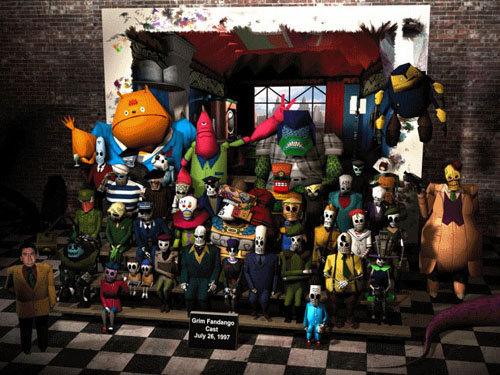The Power of Language in Games
September 3rd, 2008

Language is a powerful tool. The overall significance of language regarding current art forms moves along a sliding scale dependent on the medium in question. Books survive only within the context of language, language is often crucial but by no means an essential part of music and film – as in games – is perhaps the least important. The further removed words are from creating the actual experience (and onto visual, rhythm and gameplay cues) the less significant the role of language appears to be.
Despite this paradigm, the youth of this medium (video games) places a heavy reliance on language to often fill in for the role of gameplay. We use narrative to create context in ways that gameplay cannot currently achieve. As gameplay evolves though so will its ability to self narrate the experience. We can already see this taking place with the role of context sensitive actions (Resident Evil 4) and in game narrative (Halflife 2) as examples. Hence, over time the heavy reliance of language disappears, changing its role to being another tool in the game design tool box. Ignoring the foresight though, language shall always be significant in games much as it is to movies and music. I want to use this article to explore several past examples of the diverse use of language in games. This isn’t intended to cover the complete history of language in games but rather a few noteworthy posts along the path of application.
Language in Games
Early on, games had no room for language, let alone the primitive assortment of pixels on screen. I mean how much language is required in a game of Pong? Communication, in this case can occur psychologically through gameplay. As processors developed and machines could handle more text, the birth of text based adventure games took place providing a marriage of literature and choose-your-own-adventure gameplay. Text was used as a smokescreen so that the environments and scenarios within these games could be portrayed through text instead of stressing the hardware with visuals. The role of language here is blatant; without text and the input of text there stood no game, similar to a book really.
As graphical processors began to take over, text based descriptions became obsolete, in its place were hand drawn environments. This opened the way to many new experiences, for this article though the point-and-click adventure is most prominent. While not a genre whose rules garnered a large language use, it was through the efforts of several new franchises that language became not only significant but the best part of the playing experience. I’m talking about good natured humour and wit thanks to a selection of LucasArts titles which became arguably better with each installment, right up to the brilliant conclusion of Grim Fandango in 1998 (nevermind Escape from Monkey Island). These titles became synonymous for their humour and clever writing all layed out in a way similar to text based adventures with the focus being on dialogue.

By the time point and click adventures removed the pointing and the clicking the genre was primarily on it’s way out. Generally speaking though conventional story telling and narrative in games had strengthened. Role playing games were perhaps the flag bearers for this during the earlier 16bit generation with franchises such a Final Fantasy sharing epic tales of drama, tragedy and struggle. With the standardization of 3D though, language and narrative had a stronger presence as games and hardware grew to the level of complexity to tell such stories. Most games of the time had at least a ‘cut out’ narrative with supporting dialog, the best (Metal Gear Solid, Final Fantasy, Silent Hill) raising the bar for video game narrative at the time.
Since then language in video games has walked the same progressive path with a few noticeable titles along the way. Innovations can be seen in Resident Evil 4 where foreign language is utilized to create a fear of the unknown (they are mostly cursing at you BTW). Mass Effect has extended the use of conversation trees, crafting a spiders web of consequences and results.
In recent times there has been a greater call for stronger, more professional use of narrative and language in games. It seems that since games became three dimensional, language has mostly been used to create cookie cutter storylines glued together by typically uninspired dialog. While narrative and language are by no means a necessity (some previous discussions here), their innovations (such as the ones listed) do a great deal to enhance the overall experience.



 Game Design Companion: A Critical Analysis of Wario Land 4 - $7.99
Game Design Companion: A Critical Analysis of Wario Land 4 - $7.99 Level Design: Processes and Experiences
Level Design: Processes and Experiences Speed Boost: The Hidden Secrets Behind Arcade Racing Design - $5.99
Speed Boost: The Hidden Secrets Behind Arcade Racing Design - $5.99 Adventures in Games Analysis: Volume I - $5.99
Adventures in Games Analysis: Volume I - $5.99







